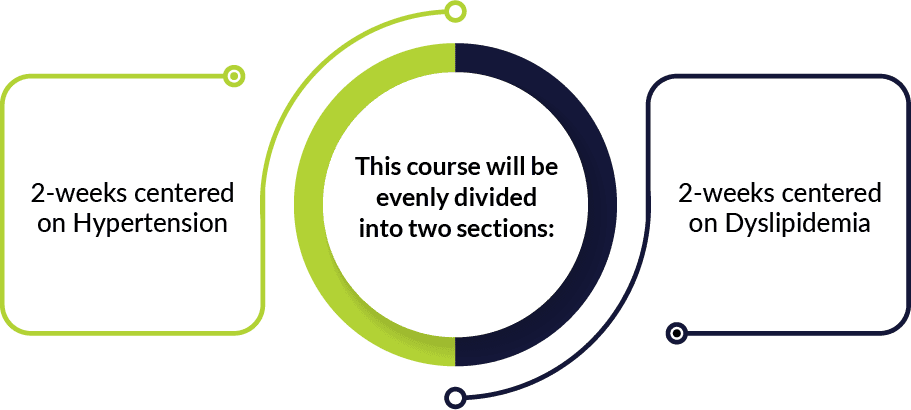Join this new course to take an in-depth scientific look into the underlying causes, mechanisms, and treatments options for hypertension and dyslipidemia through an advanced, integrative clinical lens. Through detailed reading assignments, audio presentations, daily blackboard discussions, and clinical case prompts, this course provides practitioners with a guided learning environment through which to unpack the most valuable clinical applications related to the latest data science and publications on hypertension and dyslipidemia. Centered upon student participation and engagement, this course provides the rare opportunity to spend a month learning directly from two of the nation's most highly esteemed clinical experts in integrative cardiovascular health: Drs. Mark Houston, MD and Sara Gottfried, MD

Faculty

Mark C. Houston, MD, MS, FACP, ABAARM Dr. Mark Houston is the Director of the Hypertension Institute and Vascular Biology, Medical Director of the Division of Human Nutrition and Medical Director of Clinical Research at the Hypertension Institute in Nashville, TN.

Sara Gottfried MD is a board-certified gynecologist and physician scientist. She graduated from Harvard Medical School and the Massachusetts Institute of Technology, and completed residency at the University of California at San Francisco.
Register
Pathophysiology, Diagnosis, Testing, Treatment, Clinical Application and Cases
Hypertension
The role of nutrition, nutraceuticals, vitamins, minerals, antioxidants, weight management, body composition analysis, resistance and aerobic exercise, stress reduction, proper sleep hygiene and drugs in the integrative management of hypertension and cardiovascular disease will be based on well conducted animal and human studies from randomized controlled clinical trials and peer reviewed research and review articles.
Through this course you will learn to apply cardiovascular concepts with intensive didactic learning coupled with case presentations, applied clinical medicine, interaction with faculty and your peers.
Hypertension Learning Objectives
- Understand the pathogenesis of hypertension and the role of vascular biology, three finite vascular responses of inflammation, oxidative stress and vascular immune function), plasma renin activity (PRA) and aldosterone to select optimal integrative anti-hypertensive therapy to reduce BP and decrease CVD
- Review diagnostic testing for hypertension: 24 hour ambulatory BP (ABM), endothelial function and arterial compliance testing
- Be able to prioritize and personalize the most important nutritional, nutraceutical supplements and life style treatments for hypertension.
- Apply micronutrient testing in the treatment of hypertension
- Know the most important cardiovascular drug-nutrient interactions
- Review briefly the optimal drug therapy for hypertension and combination use with nutraceutical supplements
Dyslipidemia
The primary underlying causes of 80 percent of the cases of dyslipidemia are inflammatory macro and micronutrient intake, chronic infections and toxins. Metabolic endotoxemia and the microbiome are important in the pathogenesis of dyslipidemia. This lecture will review the pathogenesis of dyslipidemia –induced vascular disease as it relates to modified LDL, LDL particle number, LDL particle size, macrophage uptake of modified LDL, scavenger receptors, HDL particle number, size, functionality and reverse cholesterol transport and downstream mediators of inflammation, oxidative stress and immune vascular dysfunction. A detailed review of all labs that provide advanced lipid testing will be discussed.
Participants will learn a clinical integrative approach to the treatment of dyslipidemia using nutrition, lifestyle changes, exercise, weight loss, nutritional supplements and anti-lipid medications to decrease cardiovascular disease (CVD) such as angina, coronary heart disease (CHD), stroke, peripheral vascular disease (PAD) and atherosclerosis. A new revolutionary approach to prevent dyslipidemia-induced vascular disease using the development of 45 new mechanisms that cause vascular disease will be discussed and treatment of each of these will be provided.
Dyslipidemia Learning Objectives
- Review the underlying causes and mechanisms of dyslipidemia and dyslipidemia-induced cardiovascular disease.
- Understand and apply advanced lipid testing (lipid particle number and size and HDL functionality and quality) for the diagnosis and treatment of dyslipidemia in clinical practice.
- Review the underlying causes and secondary etiologies of dyslipidemia.
- Prioritize effective methods to promote vascular repair, reduce vascular damage and define the interrelationships of the cardiovascular system, gastrointestinal tract and microbiome.
- Evaluate nutrition and nutritional supplements to treat dyslipidemia.
- Review 45 new mechanisms involved in dyslipidemia-induced cardiovascular disease and review the integrative therapies.
- Discuss and evaluate Clinical Trials with Statins and other pharmacologic therapies in the primary and secondary treatment of CHD, MI and CVD.
Accreditation
This activity has been planned and implemented in accordance with the accreditation requirements and policies of the Accreditation Council for Continuing Medical Education (ACCME) through the joint providership of The George Washington University School of Medicine and Health Sciences and The American Academy of Anti-Aging Medicine. The George Washington University School of Medicine and Health Sciences is accredited by the ACCME to provide continuing medical education for physicians.
The George Washington University School of Medicine and Health Sciences designates this live activity for a maximum of 25.25 AMA PRA Category 1 Credits™.
Register
Pathophysiology, Diagnosis, Testing, Treatment, Clinical Application and Cases



